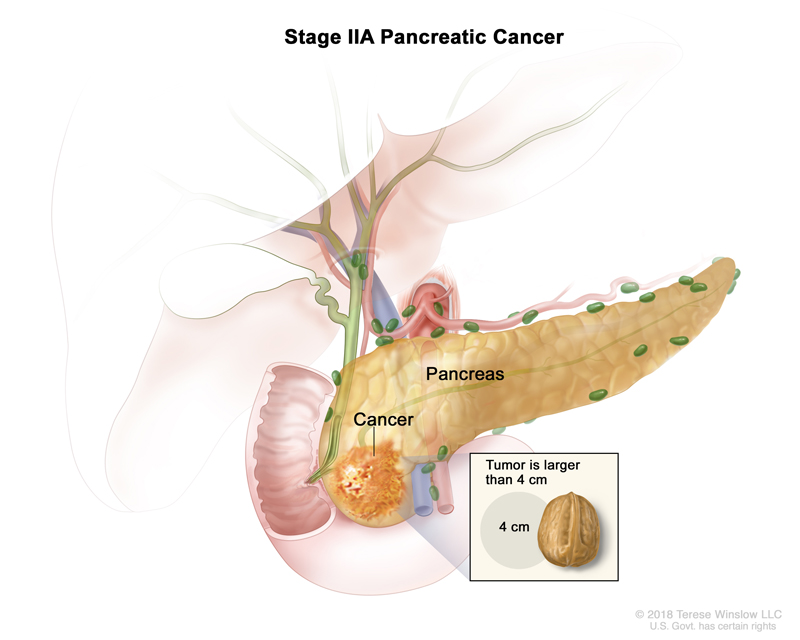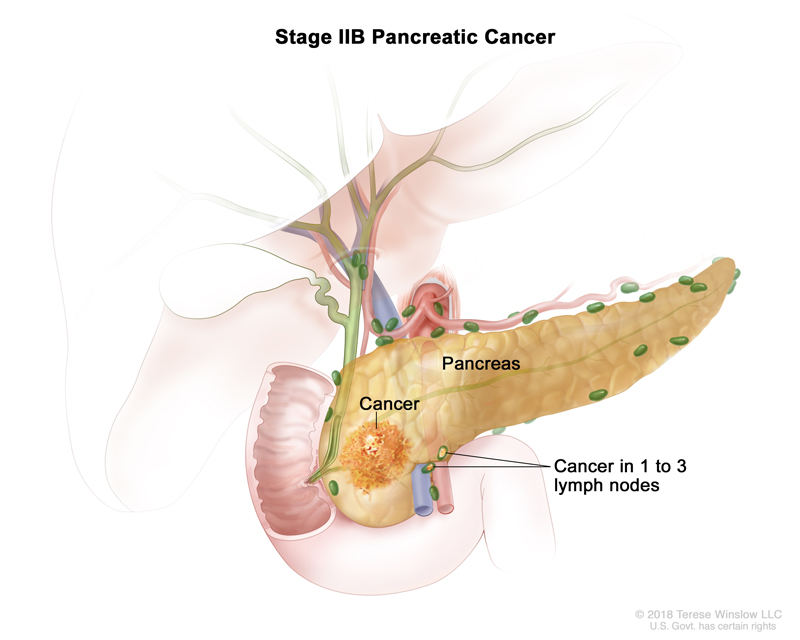Stage 2 Pancreatic Cancer ICD 10 is C25.1.
Tap “Watch Now” for an easy-to-understand overview of Stage 2 Pancreatic Cancer.
- Stage 2A Pancreatic Cancer
- Stage 2B Pancreatic Cancer
Overview
A Pancreatic Cancer diagnosis is when cancer has been found in the tissues of your pancreas.
A Stage 2A Pancreatic Cancer diagnosis means that the tumor is larger than 4 centimeters, as shown here at the bottom of the image. It’s about the size of a walnut.
What Tests Will I Need and Why?
Blood and Imaging tests are done to understand your general health, confirm your diagnosis and determine your cancer stage.
Tissue analysis can be done to identify the cancer cell type, which is critical to finding the best treatment option for you.
You may also require special Saliva or Blood Analysis to look for specific mutations (actual changes in your body’s DNA), called BRCA1 and BRCA2.
If your treatment team has not already performed tests to determine your cancer’s features, please ask your doctor when these tests will be performed.
Re-read this summary as needed and then tap, “Compare My Treatment Options Now“. Our unique Comparison Page will help you understand your FDA-approved treatment options including, who can help you pay for your treatment, where and how each is given and what side-effects you may experience.

National Institute of Health/ treatment-pancreatic
Overview
A Pancreatic Cancer diagnosis is when cancer has been found in the tissues of your pancreas.
A Stage 2B Pancreatic Cancer diagnosis means that your tumor is any size and the cancer has spread to 1 to 3 nearby lymph nodes, shown here in green.
What Tests Will I Need and Why?
Blood and Imaging tests are done to understand your general health, confirm your diagnosis and determine your cancer stage.
Tissue analysis can be done to identify the cancer cell type, which is critical to finding the best treatment option for you.
You may also require special Saliva or Blood Analysis to look for specific mutations (actual changes in your body’s DNA), called BRCA1 and BRCA2.
If your treatment team has not already performed tests to determine your cancer’s features, please ask your doctor when these tests will be performed.
Re-read this summary as needed and then tap, “Compare My Treatment Options Now“. Our unique Comparison Page will help you understand your FDA-approved treatment options including, who can help you pay for your treatment, where and how each is given and what side-effects you may experience.

National Institute of Health/ treatment-pancreatic
Recommended Pancreatic Cancer Videos

Pancreatic Cancer: Treatment and Outcomes
Overview, Treatment and Outcomes

Pancreatic Cancer: Diet & Nutrition
Managing Pancreatic Cancer

How Cancer Spreads
Metastatic = Advanced

Diagnosing Your Cancer
How Does a CT Scan Work?

Diagnosing Your Cancer
How Does a PET Scan Work?

Exercise! You Can Do It
Reducing Side Effects & More
Commonly Searched Questions
Stage 2 Pancreatic Cancer Definition
Source: Cancer.org
Stage 2 Pancreatic Cancer Survival Rate
Source: Cancer.org
Stage 2 Pancreatic Cancer Treatment
Source: Cancer.org
Stage 2 Pancreatic Cancer Symptoms
- Abdominal pain that radiates to your back
- Loss of appetite or unintended weight loss
- Yellowing of your skin and the whites of your eyes (jaundice)
- Light-colored stools
- Dark-colored urine
- Itchy skin
Source: Mayoclinic.org
Stage 2 Pancreatic Cancer Recurrence Rate
Source: Cancer.gov
Stage 2 Pancreatic Cancer Prevention
- Healthy Diet: Eat a diet rich in fruits, vegetables, and whole grains.
- Maintain a Healthy Weight: Achieve and maintain a healthy weight through balanced diet and regular exercise.
- Avoid Smoking: Do not smoke and avoid exposure to secondhand smoke.
- Limit Alcohol: Consume alcohol in moderation, if at all.
- Manage Chronic Conditions: Effectively manage conditions like diabetes and chronic pancreatitis.
Source: Cancer.gov














